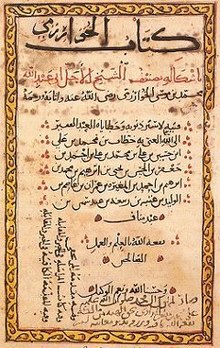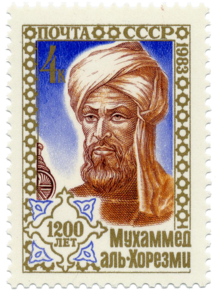al-Khwarizmi
Al-Chwarizmi , short for Abu Dschaʿfar Muhammad ibn Musa al-Chwārizmī ( Arabic أبو جعفر محمد بن موسى الخوارزمي, DMG Abu Ǧa'far Muhammad bin Musa al-Ḫwārizmī , including al-Ḫwārazmī , Chwārazmī , Hwārizmī ), Latinized Algorismi (* 780, † 835-850), was a choresmischer polymath , mathematician , astronomer and geographer during the Abbasid heyday in Early middle ages . Although he came from the Iranian Khorezmia, he spent most of his life in Baghdad and worked there in the " House of Wisdom ", a kind of academy. The term algorithm is derived from its name .
Al-Chwarizmi, who dealt with algebra as an elementary form of investigation, is considered one of the most important mathematicians. He also made significant contributions as a geographer and cartographer , including translations from Sanskrit and Greek.
Life
The exact year of birth and death of al-Khwarizmis are not known, but the librarian Ibn an-Nadim writes about him that he was of Choresmic origin (wa-aṣlu-hu min Ḫwārizm). He has his life in most of Baghdad , the capital of the Abbasid - Caliph spent. His main activity fell in the years 813 to 833; he was a member of the "House of Wisdom" (Bait al-Hikma) of the caliph al-Maʾmūn and wrote all of his works in Arabic. The historian at-Tabarī is the only one who also attributes the Nisba " al-Madschūsi " to him. From this it is inferred by some that he was a Zoroastrian , which at the time was still possible for a man of Iranian origin . However, the preface to his master book Algebra suggests that he was an Orthodox Muslim, and so at-Tabari's remark cannot mean much more than that al-Khwarizmi's ancestors, or perhaps himself in his youth, were Zoroastrians.
The first Latin translations of his algebra were made in Spain by Robert von Chester (1145) and independently a little later by Gerhard von Cremona . For example, he influenced the Italian mathematician Leonardo Fibonacci (approx. 1170–1240).
Works
mathematics
In his book on the Indian number script (around 825) - the original Arabic version of this book has been lost, it has only been preserved in a Latin translation with the title De numero Indorum - al-Chwarizmi presented the work with decimal numbers and introduced the digit zero ( Arabic .: sefr) from the Indian into the Arabic number system and thus into all modern number systems. A Latin edition of this font was entitled Algoritmi de numero Indorum ("Al-Chwarizmi on Indian numbers", Rome 1857). This later gave rise to the term “ algorithm ”, which generally means precisely defined calculation processes. The Indian numerals and the zero were already known to the Arabs and scholars of late antiquity ( Severus Sebokht ) through contacts from India, but were widely used by al-Khwarizmi.
In the year 830 he completed the work on al-Kitāb al-muḫtaṣar fī ḥisāb al-ğabr wa-ʾl-muqābala ("The concise book on the computational methods by supplementing and balancing"). It's a compilation of rules and examples. His systematic-logical approach, which was unusual for the time, gave the approaches to solving linear and quadratic equations a completely new direction, namely the geometric processing of these equations, which led to a new form of understanding for this class of tasks. This "pictorial" representation of mathematical problems not only makes the topic more tangible, but also leads to a way of gaining knowledge that is far more comprehensible for "laypeople". The achievement also consists in the fact that he has created a very efficient mathematical “tool” with it. The book was translated into Latin several times from the 12th century onwards; the term " algebra " was derived from the title of this work ( al-ǧabr ). It had a great influence on mathematics in the Middle East and then on further development in the West.
astronomy
Al-Chwarizmis [al-] Zīj al-Sindhind ( Arabic الزيج السندهند '"Sindhind Astronomical Tables"', short زيج Zīj ) consisted of about 37 chapters in which he described astronomical and calendar calculations. It contained 116 calculation tables, among which was a table with values of the sine function . The knowledge that al-Chwarizmi wrote down in the book Zīj al-Sindhind , he took over largely from Indian astronomers, to which the title Zīj al-Sindhind refers (Sindhind comes from the Sanskrit Siddhanta for textbook or treatise and Zij is that in the Islamic Common name in the world for an astronomical teaching and table work). The book Zīj al-Sindhind represented an enormous gain in knowledge for the Arab astronomers.
Al-Khwarizmi wrote the book Zīj before the year 828. The original manuscript has been lost. A version of the Spanish astronomer Maslama al-Madschriti in a Latin translation by Adelard von Bath has been handed down around the year 1000 . Adelard, in turn, built on translations by his teacher Petrus Alfonsi . The four surviving manuscripts of this version are kept in the Bibliothèque publique in Chartres, the Bibliothèque Mazarine in Paris, the Spanish National Library and the Bodleian Library in Oxford.
Because of the poor tradition, it is not certain whether al-Khwarizmi did not write two different books under the title Zīj .
geography
Another major work by al-Khwarizmis is the book on the image of the earth (كتاب صورة الأرض, Kitāb Ṣūrat al-arḍ), which he finished in 833. It is a revised and expanded version of Ptolemy's Geography, which contains a list of 2402 coordinates of cities and other geographical locations. There is only one surviving copy of the work in the Bibliothèque nationale et universitaire de Strasbourg ; it was edited by Hans von Mžik (Leipzig 1926)
Further publications
Al-Chwarizmi also dealt with the Jewish calendar (Istichradsch Tarich al-Yahud), calendars in general (Kitab at-Tarich) and sundials ( Kitab ar-Ruchmat ). The trigonometric tables he created had a great influence on the development of Western mathematics.
Honors
A postage stamp with his portrait was issued in the Soviet Union in 1983 . A memorial was erected in his honor in Khiva (Uzbekistan). A public research institute bears his name in Tunisia . The "Festival Kharazmi" ( Persian : Dschaschnvare-ye Charazmi), in which prizes for inventive research are given to young people , has existed in Iran for over 40 years . On the back of the moon there is a crater named after al-Khwarizmi. An asteroid was named after him in 2015: (13498) Al Chwarizmi .
literature
- Louis Charles Karpinski, Robert of Chester's Latin Translation of the Algebra of Al-Khowarizmi: With an Introduction, Critical Notes and an English Version, London 1915, online at archive.org
- Kurt Vogel : Mohammed ibn Musa Alchwarizmi's Algorism. The earliest textbook on calculating with ind. Digits. Zeller, Aalen 1963
- Menso Folkerts : The oldest Latin script on Indian arithmetic according to al-Ḫwārizmī, publisher of Bayer. Akad. Der Wiss., Munich 1997, ISBN 3-7696-0108-4 , text and translation of the “Dixit Algorismi” manuscripts in New York (Hispanic Society of America, HC 397/726) and Cambridge (University Library, Ii. 6.), facsimile (b / w) from the New York manuscript
- Fuat Sezgin : History of Arabic literature, Volume 5, pp. 228-241, Leiden 1974
- Ali Abdullah al-Daffa '; The Muslim contribution to mathematics. London: Croom Helmet. 1977 ISBN 0-85664-464-1
- Aydin Sayili (ed.) / Frederic Rosen ( transl .): Al-Khwârazmi's Algebra. Islamabad: Pakistan Hijra Council. 1989, ISBN 969-8016-28-7
- Edward Stewart Kennedy: A Survey of Islamic Astronomical Tables. Philadelphia: American Philosophical Society 1956
- Gerald J. Toomer : Al-Khwārizmī, Abu Ja'far Muḥammad ibn Mūsā . In: Charles Coulston Gillispie (Ed.): Dictionary of Scientific Biography . tape 7 : Iamblichus - Karl Landsteiner . Charles Scribner's Sons, New York 1973, p. 358-365 .
Web links
- Literature by and about Al-Chwarizmi in the catalog of the German National Library
- Al-Chwarizmi on Lost Islamic History
- The astronomical tables of Muhammed Ibn Mūsā al-Khwārizmī (Latin with German commentary)
- Al-Khwarizmi, Abdu'l-Hamid Ibn Turk and the Place of Central Asia in the History of Science - on muslimheritage.com
- Al-Khawarizmi (780 - 850 CE) - Short biography on muslimheritage.com
- Overbay, Schorer, and Conger: Al-Khwarizmi (Eng.)
- John J. O'Connor, Edmund F. Robertson : Abu Ja'far Muhammad ibn Musa Al-Khwarizmi. In: MacTutor History of Mathematics archive .
Individual evidence
- ↑ Ibn an-Nadim: Fihrist. Ed. Riḍā Taǧaddud. Tehran 1971. p. 333
- ↑ John J. O'Connor, Edmund F. Robertson: Abu Ja'far Muhammad ibn Musa Al-Khwarizmi. In: MacTutor History of Mathematics archive
- ↑ Toomer, G., “Al-Khwārizmī, Abu Jaʿfar Muḥammad ibn Mūsā,” in Gillespies Dictionary of Scientific Biography, vol. 7, New York: Charles Scribner's Sons, 1990: "Another epithet given to him by al-Ṭabarī," al-Majūsī ", would seem to indicate that he was an adherent of the old Zoroastrian religion. This would still have been possible at that time for a man of Iranian origin, but the pious preface to al-Khwārizmī's Algebra shows that he was an orthodox Muslim, so al-Ṭabarī's epithet could mean no more than that his forebears, and perhaps he in his youth, had been Zoroastrians. "
- ↑ He wrote the book and his "Algebra", later dated according to Toomer (Dictionary of Scientific Biography), under the government of al-Mamun (813-833) in Baghdad.
- ↑ Helmuth Gericke: Mathematik in Antike und Orient, Berlin 1984, p. 263.
- ↑ Muḥammad Ibn-Mūsā al-H̱wārizmī: The oldest Latin script on Indian arithmetic according to al-Ḫwārizmī . Ed .: Menso Folkerts, Paul Kunitzsch. Publishing house of the Bavarian Academy of Sciences, Munich 1997.
- ↑ Sayili, Al-Khwārazmi's Algebra , pp. 4-5
- ^ Kennedy, Survey, p. 128
- ↑ Sayili, Al-Khwârazmi's algebra, page 4
- ↑ source .
- ↑ al-Khwarizmi the-moon.wikispaces.com; Al-Khwarizmi (crater) engl. Wikipedia
| personal data | |
|---|---|
| SURNAME | al-Khwarizmi |
| ALTERNATIVE NAMES | Abu Abdallah Muhammad ibn Musa al-Khwarizmi; Algorismi |
| BRIEF DESCRIPTION | Muslim polymath (mathematician, astronomer, geographer) |
| DATE OF BIRTH | around 780 |
| PLACE OF BIRTH | Khoresmia , present-day Uzbekistan , or al-Qutrubbulli, Iraq |
| DATE OF DEATH | between 835 and 850 |
| Place of death | Baghdad , Iraq |


